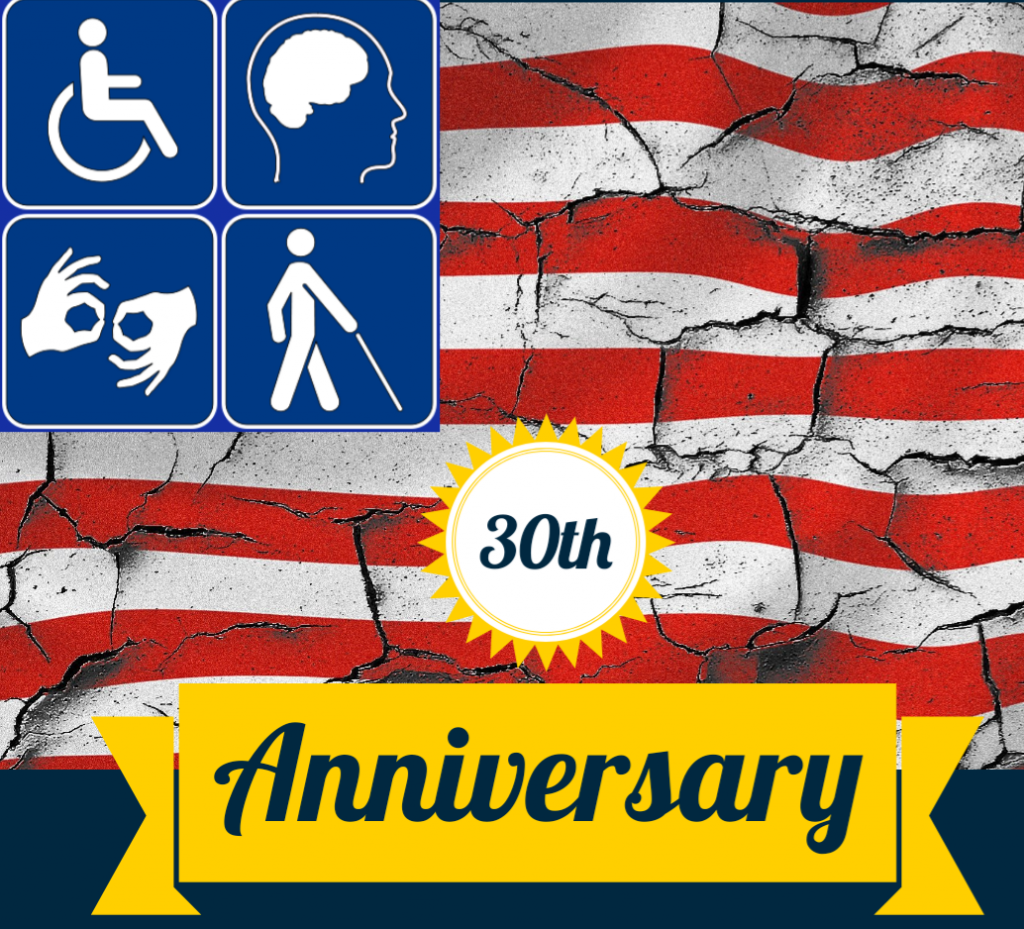

2020 is a monumental year in American history–it marks the 30th anniversary of the Americans with Disabilities Act (hereinafter the “ADA”). This landmark civil rights statute has broken many barriers for millions of Americans with disabilities. It has had a positive impact by ensuring equal opportunity, independence, and full participation of people with disabilities in American society. Despite the positive impact the ADA has had on the disability community, many individuals still face various challenges in many aspects of daily life, including a lack of access and equal opportunity within the workplace, public and private places of accommodation, and schools.
Background
The passage of the ADA did not occur overnight. Prior to 1988, when the first ADA was introduced to Congress, individuals with disabilities began to challenge societal barriers that excluded them from their communities. For example, parents of children with disabilities began to fight against the segregation and exclusion of their children within all aspects of daily life. People with disabilities and advocates sat in federal buildings, obstructed the movement of inaccessible buses, and marched through the streets to protest injustice. As a result of their tenacious advocacy, Congress passed the ADA in 1990. The purpose of the ADA is to provide a clear and comprehensive national mandate for the elimination of discrimination against individuals with disabilities. More specifically, it prohibits discrimination against people with disabilities in employment, state and local government services, public accommodations, commercial facilities, transportation, and telecommunication.
The Definition of “Disability”
The ADA defines an individual with a disability as someone who has: (1) a physical or mental impairment that substantially limits one or more major life activities; (2) a record of such an impairment; or (3) is regarded as having such impairment.
The ADA and the definition of disability more specifically have been the subject of much litigation and interpretation. In fact, there have been at least twenty United States Supreme Court cases about disability-related issues, four of which narrowed the definition of a disability. One such case was Sutton v. United Air Lines, Inc. In Sutton, the plaintiffs were twin sisters who were denied employment opportunities as commercial pilots because they were unable to meet the requirements of the airline vision standard without the assistance of corrective lenses. The Sutton sisters were both severely myopic, with uncorrected vision worse than 20/200. The plaintiffs argued that they were discriminated against by the airline company on the basis of a disability. The United States Supreme Court disagreed and concluded that mitigating measures such as medication, prosthetics, hearing aids, other auxiliary devices, diet and exercise or any other treatment must be considered in determining whether an individual has a disability under the ADA. Because the Sutton sisters corrected their vision with lenses, the Court held that they were not disabled. This decision aligned with the Court’s narrow interpretation of disability at that time.
What is the ADA Amendments Act of 2008?
In 2008, the Americans with Disabilities Act Amendments Act (the “ADAAA”) was signed into law and amended the Americans with Disabilities Act of 1990. The ADAAA was enacted to counteract the Supreme Court’s narrow interpretation of disability and provide broad protection from discrimination, thereby superseding several Supreme Court decisions, including Sutton. Further, in enacting the ADAAA, Congress made it easier for individuals seeking protection under the ADA to establish that they have a disability. The statute also shifted the focus from whether the individual seeking the law’s protection fit within the meaning of the statute to whether that individual had experienced discrimination. In so doing, the ADAAA increased the number and types of persons protected under the ADA.
What More Needs to Be Done?
Although access has improved for over sixty million Americans living with disabilities, advocates argue that there is still a lot of ground to cover. People with disabilities are still facing challenges with economic stability, equal opportunity, and inclusion. For example, one major issue affecting individuals with disabilities is the heightened unemployment rate. According to the Bureau of Labor Statistics, in 2019, the unemployment rate for persons with a disability was at 7.3 percent, compared to 3.5 percent for individuals without a disability. To address this disparity, advocates for disability rights are fighting for fair wages, seeking to end labor market discrimination, and supporting the contributions made by people with disabilities. Advocates believe that a more equitable and inclusive society will develop from creating such economic stability and protecting the rights and liberties of individuals with disabilities.
Conclusion
For almost thirty years, the ADA has afforded individuals with disabilities much needed and long overdue opportunities to battle the historical discrimination against them. It is seen by many as the first comprehensive federal statute addressing discrimination for the purposes of achieving equality, inclusion, and access for all. However, the fight goes on–to this day, individuals with disabilities continue to experience challenges in various aspects of public life. Through continued efforts in policy development, education, and outreach, individuals with disabilities will continue to receive the support and protection that they deserve to achieve equal opportunity and access to the mainstream of American life.
Sources
Abigail Abrams, Elizabeth Warren Unveils Plan to Help People with Disabilities, Time (Jan. 2, 2020).
Chia-Yi Hou, The Americans with Disabilities Act is Turning 30, The Hill (Jan. 20, 2020).
Leo Hindery Jr., Challenges Persist 30 years after Americans with Disability Act, S.F. Chron. (Feb. 4, 2020).
Sutton v. United Air Lines, Inc., 527 U.S. 471 (1999), overruled by ADA Amendments Act of 2008, Pub. L. No. 110–325, 122 Stat. 3553 (2008).
U.S. Dep’t of Labor, Bureau of Labor Stat. Rep. (2020).
42 U.S.C. § 12101(b)(1)–(4) (2012).
42 U.S.C. § 12102 (2012).

